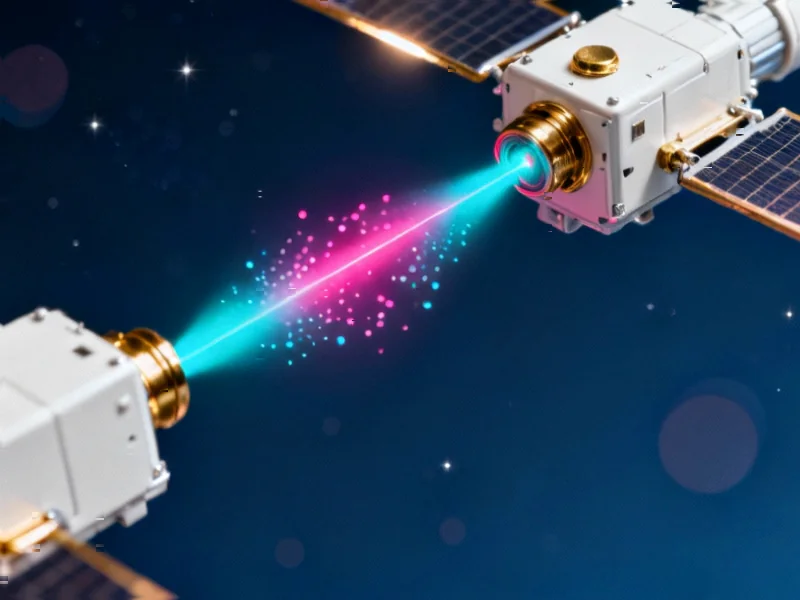The Dawn of Instantaneous Space Connectivity
In a groundbreaking development for space-based data systems, Muon Space has announced it will become the first external partner to integrate Starlink’s laser communication technology into its satellite constellation. This strategic partnership marks a significant leap forward in orbital data transfer capabilities, promising to revolutionize how we collect and utilize information from space.
Table of Contents
The collaboration will see Muon’s upcoming Halo spacecraft equipped with SpaceX’s mini laser terminals, enabling seamless integration into Starlink’s existing low-Earth orbit (LEO) mesh network. With the first laser-equipped satellite scheduled for launch in 2027, this technology promises to eliminate the connectivity bottlenecks that have long plagued satellite operations.
Overcoming the “Little Straw” Problem
Traditional satellite systems have struggled with what Muon Space President Gregory Smirin describes as the “little straw of connectivity” problem. Current Earth observation satellites typically experience significant delays in data transmission, often waiting hours or even days to download information when they pass over ground stations.
“Most of the Earth observation and analytics in space have been constrained at a systems level by this limited connectivity,” Smirin explained. “The data pipeline gets pinched most of the time and only establishes reliable connection intermittently.”
Starlink’s laser technology changes this paradigm entirely. The system supports 25Gbps connections between satellites at distances up to 4,000 kilometers, with even higher data rates possible at shorter ranges. This creates a persistent, high-bandwidth network that satellites can access continuously throughout their orbits.
Technical Breakthrough: From Dial-Up to Always-On Space Internet
The comparison to terrestrial internet evolution is particularly apt. Smirin equates the shift to moving from dial-up modem connections to today’s always-on broadband access. The laser communication system reduces latency to mere milliseconds while maintaining end-to-end encryption to protect sensitive customer data.
What makes this development particularly significant is that Muon will be the first company outside SpaceX to utilize this advanced technology. The same laser terminals that currently power Starlink’s global mesh network will now be available to external partners, representing a major step in the commercialization of space-based infrastructure.
Real-World Impact: Transforming Emergency Response and Environmental Monitoring
The implications extend far beyond corporate announcements. One of the most immediate applications will be in wildfire monitoring and response through Muon’s work on the FireSat system, developed in partnership with Google and the Earth Fire Alliance., according to industry developments
During recent wildfires in Los Angeles, traditional observation methods failed when smoke and high winds prevented aircraft from flying overhead. With laser-enabled satellites, emergency responders could receive continuous, real-time data about fire direction and progression, enabling better deployment of personnel and equipment., as earlier coverage
“We’re providing five to ten times the capacity that the rest of the new space industry is providing,” Smirin emphasized. “This represents a massive step forward in our ability to monitor and respond to environmental emergencies.”
The Future of Persistent Space Connectivity
By 2027, when the first laser-equipped Muon satellites launch, consumers and businesses will begin to see the tangible benefits of this persistent connectivity. The technology promises to make space-based data as accessible and reliable as ground-based internet services.
As Smirin noted, “Space is becoming a ground truth enabler.” The ability to maintain constant, high-speed connections between satellites creates new possibilities for climate monitoring, disaster response, agricultural management, and countless other applications that depend on timely Earth observation data.
The partnership between Muon Space and Starlink represents more than just a technological upgrade—it signals a fundamental shift in how we conceptualize and utilize space-based infrastructure. By breaking down the communication barriers that have limited satellite effectiveness, this laser technology opens new frontiers in our ability to understand and respond to conditions on our planet.
Related Articles You May Find Interesting
- Samsung Galaxy XR: Pricing, Availability, and Exclusive Bundle Details for the A
- Samsung Galaxy XR Headset Launches as Android’s First Premium VR Competitor
- The Unseen Enemy: How Insider Threats Are Reshaping Cybersecurity Defense Strate
- Google hits back at the CMA’s ‘strategic market status’ ruling
- Reddit’s Legal Battle Against Perplexity AI Signals New Era in Data Governance f
References & Further Reading
This article draws from multiple authoritative sources. For more information, please consult:
- https://www.starlink.com/residential/cnet?referral=RC-DF-5246682-75930-55&utm_source=%5B%E2%80%A6%5Dum=affiliate&utm_campaign=affiliate_ziffdavis_editorial-cnet
- https://www.google.com/preferences/source?q=cnet.com
This article aggregates information from publicly available sources. All trademarks and copyrights belong to their respective owners.
Note: Featured image is for illustrative purposes only and does not represent any specific product, service, or entity mentioned in this article.



